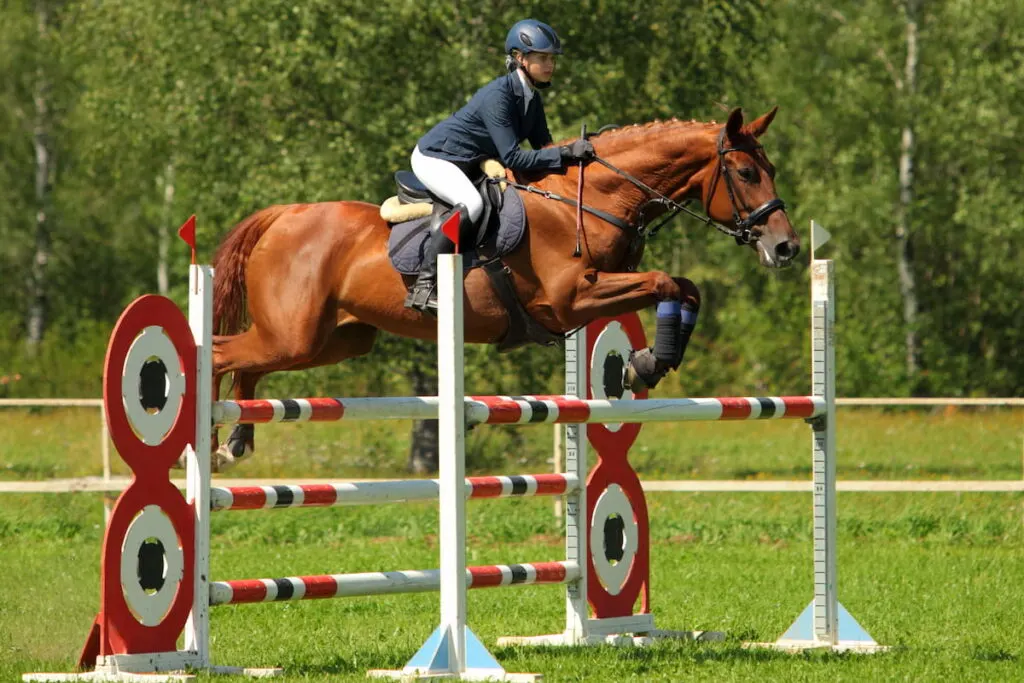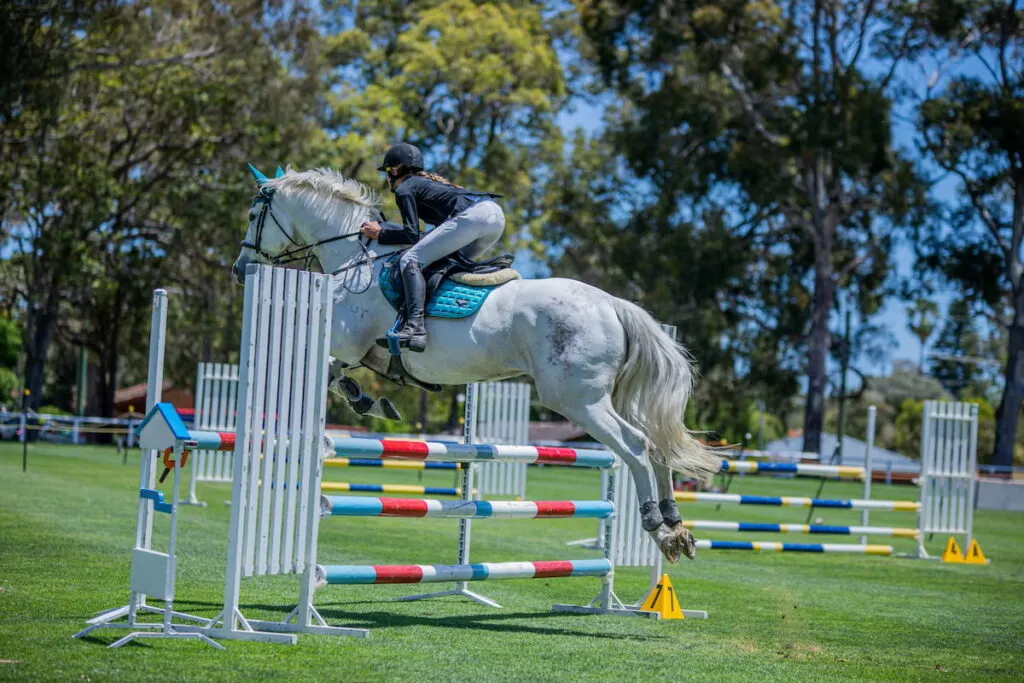If you’ve ever been to a horse show, you may have seen horses jumping many different kinds of obstacles. Equestrian jumping course designers choose specific types of obstacles based on the type of event and the level of difficulty they want to achieve.
Some types of obstacles are more specific to showjumping or cross-country, although there can be some overlap.

Showjumping obstacles are often brightly colored and tend to be made of materials that are easily knocked down.
Cross-country obstacles are usually solid and designed to reflect natural elements you’d find out in nature – or on a fox-hunt. Here are 29 types of horse jumps, explained!
Table of Contents
Helpful Jumping Terms
- Showjumping. An equestrian event in which speed and accuracy over jumps matter more than form. Knocked or fallen rails incur time penalties that hinder a rider’s score.
- Cross–country. Equestrians race through the forest over a cross-country course, which is the second element of a 3-day eventing competition. Obstacles may include galloping through water, scrambling down sloped banks, or jumping other man-made obstacles.
- Poles or rails – Long wooden poles that rest in cups attached to a standard.
- Cavaletti – Small x-shaped standards that hold poles. Cavaletti poles help train both horse and rider to achieve the appropriate striding between jumps.
- Standard – Bases for jumps that hold poles. They have many holes that are used for adjusting the height of the u-shaped cups that hold the poles in place.
- Bounce. Setting up jumps or Cavaletti poles close together requires a horse to jump them in rapid succession, without taking several strides in between. Evenly spaced Cavaletti poles are often used to practice trotting and other ground exercises as well.
- Combination. Any combination of jumps or obstacles. Some obstacles inherently include several elements, such as a Coffin or Normandy Bank. In showjumping, a combination may consist of two verticals placed closely together, requiring a bounce stride in between.
Show Jumping Fences
Crossrail

A basic crossrail jump is simply that – a jump that consists of two crossed rails (or poles). One end of the pole is set in a standard, and the other end lays on the ground. This forms an “x” in the center of the jump and is designed to encourage new jumpers to remain straight. Crossrails are used for teaching beginners, training young horses, or warming up before tackling a bigger course.
Vertical

One of the most common types of jumps, a vertical consists of poles placed evenly between two standards. Verticals come in all shapes and sizes, and they may have decorative elements beneath the top pole (such as flower boxes or decorative arches). At a top showjumping competition, you may see a vertical with three, four, or even five poles!
Oxer

Oxers are wide jumps made with two sets of standards placed relatively close together. This increases the width of the jump, as the horse has to clear the elements of both sets of standards at the same time. The overall height and width of the spacing between the sets of standards vary depending on the level of competition.
Ascending Oxer
In an ascending oxer, the top pole in one set of standards is placed slightly higher than the other, so that the horse has to “ascend” over the jump. The opposite of this jump is called a descending oxer, but these are prohibited by the FEI because of safety issues.
Square Oxer

For a square oxer, both top poles are set evenly at the same height creating a nice “square” jump. These are handy because they can be jumped in either direction, and are also commonly used in practice and for training purposes.
Swedish Oxer
Like with a crossrail, the poles of a Swedish oxer are set higher on one side of the jump and lower on the other. Because there are two sets of standards, this creates a formidable oxer with an “x” shape.
Triple Bar
A triple bar is a vertical jump that uses three separate sets of standards. These jumps vary in height and design, and all three rails may be contained in a single large standard. The top poles may also be set at different heights as well. The standards of a triple bar may be set quite far apart from each other in the highest levels of competition, which creates a very tall and very wide obstacle.
Hogsback
This is a triple bar jump in which the rail in the middle standards is set higher than those on either side. This gives the jump the appearance of a “hogs’ back.”
Fan
These triangular shaped jumps are made from several ascending rails. They are similar in shape to a cross-country corner jump, and should be jumped at the narrowest part of the triangle. A fan jump looks like a splayed fan when viewed from above, and may only use a single standard on one side – but three on the other.
Liverpool

A Liverpool is a type of water jump with an obstacle placed over it (either an oxer or a vertical). They’re narrower than open water jumps, and are more of a “high jump” than a “long jump”. Sometimes a Liverpool will be completely dry, using a tarp instead of a pool of actual water.
Open Water
These water jumps are long, shallow troughs of water. In stadium jumping, horses may not touch the water with their feet, and the landing marker is defined with a moldable substance called plasticine. A horse that falls too short will mark the plasticine and receive a penalty (as though they had knocked a rail). In cross-country, horses may end a drop fence in water, but they are usually encouraged to run through it rather than jump over it.
Wall

Solid walls may look like formidable jumps, but they are made of stacked lightweight foam bricks. A show jumping wall will easily tumble to the ground if the horse crashes into it.
Cross-Country Obstacles
Arrowhead
These solid triangular jumps have a narrow base and a wide top. They have an ascending pitch and are usually made of wood. Sometimes they appear in a show jumping course, but with the addition of a top rail (or rails) that may be knocked down.
Bank
A bank obstacle may refer to a natural sloped bank or a made-made series of wide steps. Sometimes a bank will lead down into water. Other times, the bank will lead to a small plateau and be immediately followed by another bank to get down. Banks are often used as elements in combination obstacles as well.
Brush Fence
A solid fence with brush placed on top, these types of fences are also found in steeplechase racing. For brush fences, the goal is to jump through the brush, rather than clean over it. Brush is often used as a decorative element for a lot of obstacles in both showjumping and cross-country.
Bullfinch
These brush fences consist of several feet of brush – they’re supposed to be jumped through, rather than over. Because the horse cannot clearly see the landing, he must trust his rider to guide him.
Coffin
These tricky combination obstacles consist of three parts – the horse must jump an obstacle, then navigate down to a ditch, and then jump up and over another obstacle. They may vary in design, but jumping a coffin requires a rider to be organized and attentive. They often employ a well-timed “coffin canter” to tackle this complicated cross-country jump.
Coop
This solid pyramid-shaped jump looks like the long roof of a chicken coop. They may be slightly rounded, or they may also have poles placed across the top for extra height.
Corner
This difficult fence is shaped like a triangle and set horizontally. The goal is to jump the narrowest part of the triangle, as it may be too wide for the horse to jump over the base. They require a skilled equestrian and an experienced horse to tackle, and they are therefore only seen at higher levels of competition.
Ditch
A ditch is just that – a long ditch in the ground that the horse must jump over. They vary in width, but ditches can exceed 11 feet wide at the upper levels of competition. You may also see a ditch as part of a combination (such as with a coffin fence or a Trakehner). Small ditches are also good practice jumps for trail riders as well!
Drop fence

With a drop fence, a horse jumps an obstacle and lands on a lower level than the approach. A drop fence can be simply jumping off of a bank, or jumping an obstacle and landing on a lower elevation.
The rider should avoid dropping too early, and must stay centered on the horse as he negotiates the drop. This also requires a lot of trust from the horse, since he often can’t see where he’s about to land until the very last second.
Log
These are the most common type of fences in cross-country. They’re made from solid logs, and won’t fall down if they’re knocked. Because of this, they must be approached boldly and with good balance and impulsion.
Trakehner

A Trakehner jump consists of logs or rails placed over a ditch. In the Trakehner horse’s homeland of Prussia, the wetlands were emptied using networks of drainage ditches. They covered these ditches with rails, and used these jumps to test the jumping prowess of young horses for breeding and military use.
Normandy bank
Like a coffin, a Normandy bank is a combination obstacle that includes a ditch followed by a bank, and then another obstacle on top. The horse must jump the ditch onto the bank, and then clear the next obstacle in rapid succession. Combination obstacles can be difficult a tricky to master.
Rolltop
A rolltop is a rounded jump that appears on a cross-country course in solid form, or it may be used as filler in showjumping rings. They have a half-barrel shape, and can sometimes be quite wide.
Shark’s tooth
A shark’s tooth jump consists of several upside-down triangles spawning from a top rail. These triangles resemble a row of pointy “shark’s teeth,” hence the name. The overall shape of the jump resembles a coop – except it’s a chicken coop with teeth!
Skinny
Skinny fences refer to any narrow obstacle. They’re often used in tricky combinations in the upper levels because inexperienced horses can run right by them with an inaccurate rider. Sometimes they are only wide enough for a horse to pass through, and are marked with flags instead of standards.
Sunken road
A Sunken road is a complicated combination obstacle that consists of rails and two banks. In a common variation of this sequence, a horse would jump a rail, ride down a bank, take a stride at the bottom of the “road”, scramble up another bank, and possibly finish by jumping another obstacle. (source) Whew!
Table
A table is a large solid oxer. Horses should jump the entire obstacle, but may occasionally land on top of it and then jump off. They may be quite wide at the upper levels.

